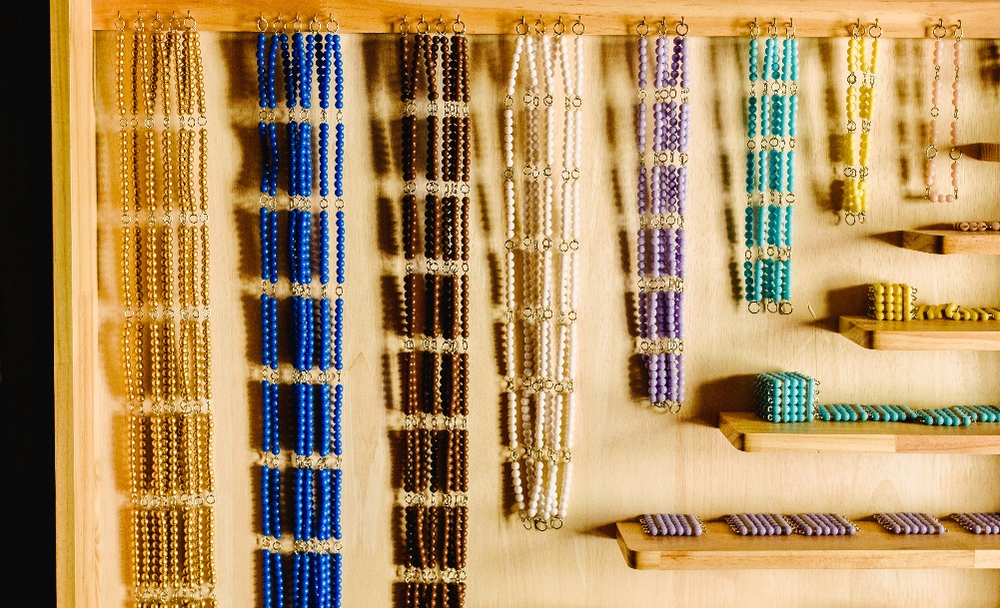
The Math materials are an essential part of the Early Childhood classroom, designed to respond to what we understand about development at this age. Each lesson offers a single concept for the child to explore, presented concretely and elegantly, with self-correcting elements that allow the child to determine independently if they've finished the work. You see supports for the development of the child's mathematical mind across the classroom, in the same way that the physical environment contributed to this growth in the infant and toddler classrooms. Language is precise, materials are orderly and sequenced in a logical way. Concepts are consistent across their application in the classroom, whether the child is comparing dimensions in the Sensorial materials or pouring water into different sized vases in Practical Life. Habits of mind, like the patterns of the Base Ten number system, are integrated across the classroom, understanding that children learn through their engagements all day long and not just when they're in a formal "Math lesson."
And those formal Math lessons? They're the gold standard in Montessori for the order, precision and exactness of the classroom. Each concept is presented specifically, in a lesson the child can explore independently, emphasizing that math isn't some abstract monster that people don't like or aren't good at, but that we are all mathematical thinkers learning a universal language that helps us to understand and act upon our environment every day.
In Early Childhood, the Math materials begin with specific lessons on numerals and parallel lessons on quantity. A child learns the shape and names of numbers separate from their early explorations with the quantities those numbers represent, then combines those early experiences into lessons that match numeral and quantity. No concept is left to chance: early lessons include everything from the concept of "zero" to determining odds and evens. These initial lessons in Math, which often follow the same structures of the Sensorial materials with which the child has been able to explore earlier, often move quickly for children, a reflection of the child's sensitivity to order, to language and to precision at this age. After those foundational experiences with concepts of 1-10, the child moves to explorations with the decimal system, then to the quirky names of numbers between 11 and 19, and then to the exploration of how we can manipulate the interaction of these ideas once we know how to describe them.
Similarly, a child learns place-value through concrete experiences with series of tens, mastering the idea that, in a Base Ten system, each new collection (units, tens, hundreds, thousands, and so on) is just a set of ten of the previous collection. Once those initial concepts are mastered, Montessori classrooms attract children's excitement about working with very large numbers by introducing the operations through hands-on, full-body lessons. Two or three children may work together to lay out forty-five units, forty-five tens bars, forty-five hundred squares, and forty-five thousand cubes, labeling each set from 1 to 9000. You may see children using those same concrete materials to practice multiplying and dividing four digit numbers. Because we know children love experiences that let them use their whole bodies, because we know they love using large numbers and working with purpose, the materials are designed to allow just that. Instead of seeing children hunched over practice worksheets and rote-memorization, you'll see them moving around the classroom, with their peers, exploring the relationships of number and quantity and learning to master them.
Remember: the development between 3 and 6 is highlighted by a motivation to name, classify, order and sequence the world around the child. Understanding math gives children a sense of agency and influence in that world. That motivation raises the expectation for us as teachers and parents: children are listening carefully, learning from every interaction with the world around them. When we present logical, orderly, and precise experiences with that world, we support the child's confidence that they are safe here, that they have influence. When we give them accurate experiences with the foundational concepts of math, we offer them language to describe their world and the understanding to control it. When we do these things through beautiful, elegant, wonder-filled materials, we remind the child that math is also beautiful, elegant and wonder-filled, and inspire their curiosity and their love of learning.
#Math #FirstPlane #Primary #ForParents #ForTeachers #Curriculum
